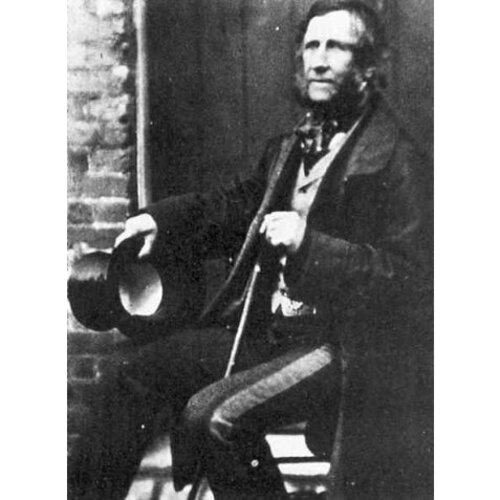
Source: Courtesy of Wikimedia Commons
JEBB, Sir JOSHUA, military engineer; b. 8 May 1793 at Chesterfield, Derby, England, eldest son of Joshua Jebb and Dorothy Gladwin; m. first Mary Legh Thomas, by whom he had four children, and secondly, Lady Amelia Rose Pelham; d. 26 June 1863 at Chesterfield.
Joshua Jebb graduated from the Royal Military Academy at Woolwich and was commissioned 2nd lieutenant in the Royal Engineers in 1812. The following year he rose to 1st lieutenant and was posted to Canada. He was recommended for his participation in the battle of Plattsburgh on 11 Sept. 1814. Jebb remained in Canada after the war and performed minor duties for the military in Brockville and Quebec, including service as a commissioner to evaluate damaged buildings and estimate costs of repairs and construction.
His most significant work in Canada, however, was his survey of a canal route between Kingston and the Ottawa River. The War of 1812 had demonstrated to Sir George Prevost*, Sir Gordon Drummond*, and other officers that American forces could easily cut the strategic St Lawrence supply and communications link between Upper and Lower Canada. They felt that a route remote from the boundary was needed. In April 1816 Jebb was instructed to survey the Rideau chain of lakes and rivers with a view to developing it by means of canals into a secure, interior communication route. Surveys of the Rideau route had been made in 1783 and 1812 and Jebb’s task was to provide specific plans for a canal’s construction. He was also instructed to assess the suitability of the adjacent terrain, especially along the St Lawrence river front, for settlement by retired British soldiers.
By June 1816 Jebb had completed the survey. His report recommended a route from where the Rideau emptied into the Ottawa River westward to Irish Creek, approximately five miles south of Smiths Falls. The route then followed this creek to Irish Lake, at which point Jebb, concerned to keep the costs low but eager nevertheless to use novel concepts wherever possible, proposed to build a five-mile long marine railway instead of a canal to a navigable point on the shallow Gananoque stream. An abandoned iron forge nearby could be used to make the rails and the road would be of great economic value to settlers in the area. By means of canals and locks the Gananoque would lead to Whitefish and Cranberry lakes and then by way of the Cataraqui River to Kingston on Lake Ontario.
Shortly after Jebb’s report was presented military settlements were established at March, Richmond, and Perth. His route, however, was not followed by Colonel John By* when construction of the Rideau Canal began in 1826. By felt that the low water level in Irish Creek and the lack of continuous flow to the Cataraqui River made Jebb’s scheme impracticable.
Still in the army, in 1820 Jebb returned to England where he used his engineering skills to design several prisons, most notably that at Pentonville, regarded for long as a model. He also exerted a strong influence on the management of penal institutions. Jebb opposed transportation of convicts in favour of employing them on public works in England. Appointed surveyor general of prisons in 1837, he served in 1844 as a commissioner to investigate punishment for military crimes and the same year became inspector general of military prisons.
Jebb retired from the army as a lieutenant-colonel in 1850 and was appointed chairman of the managing board of all convict prisons. He received the ranks of colonel in 1854 and major-general in 1860; he was created a kcb in 1859. Jebb died in 1863 after serving for two years as a commissioner to consider the construction of a portion of the Thames embankment.
Water-colours painted by Sir Joshua Jebb while he was in Canada are preserved in the Bushnell Collection, Peabody Museum, Harvard University, Cambridge, Mass. A list of Jebb’s publications can be found in the DNB. PAC, RG 8, I (C series), nominal index; RG 11, ser.1, 38. PRO, WO 55/857–87. Encyclopedia Canadiana, V, 345–46. G.B., WO, Army list, 1804–39. Hart’s army list, 1840–64. R. [F.] Legget, Rideau waterway (Toronto, 1955). Ont., Dept. of Energy and Resources Management, History of the Rideau waterway (Toronto, 1970).
Cite This Article
Kenneth E. Kidd, “JEBB, Sir JOSHUA,” in Dictionary of Canadian Biography, vol. 9, University of Toronto/Université Laval, 2003–, accessed December 14, 2025, https://www.biographi.ca/en/bio/jebb_joshua_9E.html.
The citation above shows the format for footnotes and endnotes according to the Chicago manual of style (16th edition). Information to be used in other citation formats:
| Permalink: | https://www.biographi.ca/en/bio/jebb_joshua_9E.html |
| Author of Article: | Kenneth E. Kidd |
| Title of Article: | JEBB, Sir JOSHUA |
| Publication Name: | Dictionary of Canadian Biography, vol. 9 |
| Publisher: | University of Toronto/Université Laval |
| Year of publication: | 1976 |
| Year of revision: | 1976 |
| Access Date: | December 14, 2025 |



